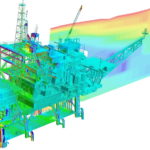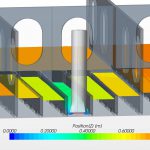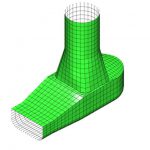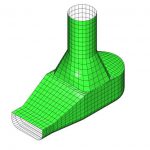Volker Bertram gives an overview of a spectrum of simulation applications in the offshore industry, from looking at the benefits for the business processes of the customers
Design and operation of ships and offshore structures increasingly rely on »virtual experience« from dedicated simulations. Scope and depth of[ds_preview] these simulations guiding customer decisions have developed very dynamically over the past decade. The »customer« may be the designer, builder or operator of an offshore installation, or any subcontractor. From a customer perspective, simulations serve to support business processes through
Ensuring low environmental impact
Ensuring high availability / utilisation
Promoting innovative designs and procedures
Ensuring compliance
Low environmental impact
Accidents like the »Exxon Valdez« and the »Deepwater Horizon« have had profound impact on the offshore industry. This does not only concern direct liability claims, but also indirect business impact due to impaired image with other stakeholders, most notably customers. Safety, also environmental safety, concerns both design and operation.
International and national regulations as well as classification society rules are taken as guidelines for what has to be assumed as worst-case scenario, e.g. »the highest wave to be expected in this region within 100 years«. Industry practice is that simulation experts follow user specifications or common practice. In most cases, the largest uncertainty in the structural assessment comes through the assumed loads. Detailed structural analyses therefore require generally dedicated other simulations to prescribe load distributions (varying in space and time):
Long-term distributions of wave loads, based on linear seakeeping methods, for fatigue analyses. For many seakeeping issues, linear analyses (assuming small wave height) are appropriate and frequently applied due to their efficiency.
Extreme wave scenarios require free-surface RANSE (Reynolds averaged Navier-Stokes equations) simulations. The computations require massive computing power and CFD (computational fluid dynamics) experts. Combining linear methods with RANSE simulations allows exploiting the respective strengths of each approach. For example, the linear analysis identifies the most critical parameter combination for a ship response. The subsequent RANSE simulation determines motions, loads and free surface (green water on deck).
Impact loads appear for slamming and sloshing analyses. Both potential-flow and RANSE simulations have been extensively validated. Mostly, these simulations assume weak fluid-structure interaction, i.e. the fluid dynamic simulation specifies the loads for the structural finite-element analyses (FEA), but the deformation is not considered for the CFD simulation. However, strong fluid-structure interaction considering also the effect of the structural response on the fluid dynamics can be simulated. Applications include springing and whipping for ships, and sloshing for tanks with very flexible membranes.
As a special case, ice loads may be considered. Simulations of offshore structures in brash ice consider e.g. the loads for dynamic positioning of drill ships. LS-DYNA, a finite-element code usually used for ship-ship collision analyses, can be applied for these simulations. But more frequently dedicated software is used.
Strength analyses have reached a mature state and are widely applied in the design of offshore structures to ensure sufficiently strong designs. Finite-element analyses (FEA) for global strength are widely applied to ships, offshore structures, and subsystems (e.g. gearboxes, engines, cranes, risers, pipelines, etc.). Particularly for offshore platforms and FPSOs, more sophisticated analyses are employed, such as fatigue analyses or collision analyses. Collision analyses are regularly performed for ships with class notation »COLL« and for offshore wind farms where authorities require proof of collision friendliness.
Operational guidelines may also be based on simulations. Progress in simulation techniques and computer hardware have led to a multitude of applications that were previously not possible at all or approximated by more expensive and/or less accurate model tests, e.g.:
Towing of damaged structures: CFD simulations are used for towed systems manoeuvring in waves. FEA simulations determine stress distributions in damaged structures, considering the actual hull structure condition including corrosion.
Oil spills: Multi-phase flows (=flows with several fluids of differing density and viscosity) can be simulated by all major commercial CFD codes. For oil spills, oil and water are considered, sometimes also air (when waves or sloshing plays a role).
Gas dispersion: Aerodynamic flows around offshore structures can be computed in great detail, with or without added smoke or gas. For gas or smoke dispersion, thermal processes and thermal buoyancy play usually a significant role and must be reflected in the simulation model. Such simulations may concern external flows (e.g. near crew quarters or helidecks) or internal flows (e.g. in working or living areas). They may also cover extreme temperatures or speeds, including supersonic, explosive leaks.
• Disposal/cleaning operations: Multi-phase flow simulations have been used for decision support in cleaning offshore structures, in regular operation or in preparation for disposal. Simulations identify e.g. stagnant flow regions in tanks or the effectiveness of cleaning procedures.
Ensuring high availability
Offshore structures usually have much higher down-time costs than cargo ships. Consequently, stronger focus is placed on ensuring high availability of these structures. This is mainly achieved through three levers, »design for availability« (system robustness), »monitoring for availability« (condition based maintenance to avoid downtime), and fast »trouble-shooting«:
Design for availability: Failure mode and effect analyses (FMEA) or related formal risk assessment techniques are widely applied to offshore systems. A »system« in this sense is not just the technical object, but includes also operational procedures. Operational guidelines for risk mitigation contribute significantly to ensuring high availability. A typical example is the specification for operational limits (sea states) for installation, maintenance and operation. Such operational limits are determined based e.g. on seakeeping simulations. The appropriate simulation tools depend on required accuracy, geometry of the object (slender monohull, catamaran, large displacement structure, hydrodynamically transparent jack-up structure, etc.) and speed through water. Increasingly, viscous CFD simulations, which can also simulate breaking waves, are employed in these analyses.
Monitoring for availability: In some applications, accepting degradation and planned replacement is more economic than designing for complete avoidance of replacements. This concerns machinery as well as structures, where corrosion is often accepted as unavoidable. In these cases, condition based maintenance schemes monitor the condition of system elements with the aim of having timely replacement and no unscheduled down-time. Condition assessment schemes for steel hulls of ships and offshore structures are not new. However, more recently initiatives have started to combine hull condition monitoring systems and structural FEA models, maximizing the data model re-use, thus reducing response time and costs for users. Within this approach, the global strength of partially corroded structures can be assessed by FEA, determining much more accurately the residual strength of a structure with locally heterogeneous corrosion. These results are the basis for risk based inspection schemes for offshore structures, equipment or FPSOs.
Trouble-shooting: The traditional trial-and-error approach to localise the source of vortex-induced vibrations may today be replaced by a more time and cost efficient search guided by CFD and vibration analyses. Unsteady CFD simulations reveal pressure fluctuations which can be matched to problematic frequencies. Then re-design of identified areas is straight-forward.
Innovative designs and procedures
The offshore industry has been (by necessity) much more innovative than the shipbuilding industry. Often, considerable benefits can be reaped by being »the first« – the first to master larger drilling depth, the first to master arctic exploration, etc. Innovation unlocks new riches, but also involves the risk of venturing into technologically unknown territory. Whenever we leave our »comfort zone« of experience moving to new designs or procedures, simulations give us most valuable insight and »virtual experience«, ensuring not only that envisioned concepts are feasible, but also efficient and safe. This approach applies to installations, individual equipment or procedures alike as illustrated by the following examples:
System design: Simulations play a role in accelerating progress in systems’ design. E.g., CFD has been applied for type approval of innovative ballast water management systems. In one case, we simulated the mixing of chlorine and ballast water in pipes during ballasting. The CFD simulations were used to determine the required pipe length of the mixing zone to ensure homogeneous mixing. Simulations showed that mixing was inefficient in the initial design. Very simple and cost-effective modifications of the inlet geometry increased the turbulence level significantly, resulting in a much shorter pipe length for complete mixing.
Global platform/hull design: Modern ship design practice employs CFD and formal optimisation to derive optimum hull shapes. Similar applications are known for offshore platforms and appendages. Parametric shape variation, advanced optimisation models and large parallel computer hardware have enabled significant design improvements in many projects in our experience. OSV (offshore supply vessels) are good candidates for formal hull optimisation, but fuel efficiency, stability, and seakeeping must be reflected in the optimisation model to find good trade-offs. Similarly, we can combine formal optimization with 3d seakeeping analyses for offshore structures, e.g. to optimize for relative motion (respectively air gap) for a given sea state.
Operational procedures – Simulations may also support operational procedures. Adequate safety against capsizing invoked by sudden loss of crane load during heavy lifts is generally ensured by satisfying the minimum intact stability regulations, i.e. by complying with a simplified criterion based on an area ratio under the righting lever curves. Alternatively, advanced simulations can be used to more accurately assess a ship’s stability by simulating its transient roll behaviour after sudden loss of crane load. By predicting e.g. maximum static and dynamic heel, a stability assessment using such simulations may lead to an approval of a lifting operation which does not comply with the simplified area ratio criterion.
Ensuring compliance
The offshore industry is under tight scrutiny by authorities. By now, simulations are widely accepted by national authorities as »engineering proof« of compliance. Typical analyses performed to obtain approval for installation concern:
Formal risk assessment: Formal risk assessment procedures, e.g. FMEA (failure mode and effect analysis), have been established in the offshore industry much longer than in shipbuilding and ship operation. Risk assessment combines typically probabilistic frameworks with dedicated simulations, especially for the »effect« part of an FMEA. Examples are collision analyses, damage stability analyses and evacuation analyses.
Occupational health and safety: International regulations, e.g. ILO (International Labour Organisation), industrial agreements and company guidelines address various aspects of occupational health and safety. The ILO Maritime Labour Convention of 2006, in force since 2013, has noticeable impact on many building specifications. One of the most important changes of the Convention addresses noise and vibrations levels in crew accommodation and work spaces. 3D FEA is the standard choice for maritime vibration analyses today. For structure-borne noise, a far more efficient approach based on statistical energy analysis (SEA) is used.
Fires: For fire simulations, zone models and CFD tools are employed in practice. Zone models are used for more complex, time-dependent scenarios involving multiple compartments and deck levels. More time-consuming CFD models are used for local details, e.g. flash-over prediction between cabins.
Evacuation simulation: Simulations become complex if human behaviour must be included automatically, as in the case of evacuation simulations. The platform is represented by a simplified grid of different cell types (accessible floor, doors, stairs, obstacles/walls). Humans are represented by simple expert systems, so-called intelligent agents. Once the model has been set up, the simulations are very fast, allowing typically 500 simulations within one hour. This is used to gain a broad basis for statistical evaluation. More advanced simulations combine damage scenarios (flooding, fire) with evacuation and possibly risk assessment.
Powerful and versatile
Simulations are, as shown, a powerful and versatile tool. The technological progress is rapid, both for hardware and software. Simulations for numerous applications now often aid decisions, sometimes ‘just’ for qualitative ranking of solutions, sometimes for quantitative ‘optimization’ of advanced engineering solutions. Continued validation feedback serves to improve simulation tools as well as it serves to build confidence.
Software is not enough
However, advanced simulation software alone is not enough. The key to success is finding the right balance between level of detail and resources (time, man-power). This modelling requires expertise and experience. Only the symbiosis of software, hardware and experts unlocks the true value that advanced engineering services can offer.
Volker Bertram






















